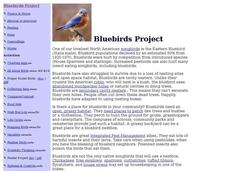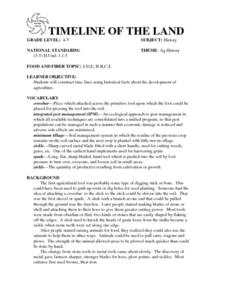Curated OER
Integrated Pest Management
Students investigate the different methods used in integrated pest management. In this biology lesson plan, students evaluate experiments and case studies on IPM. They discuss the pros and cons of using this method.
Cornell University
Let’s Raise Lacewings
Young entomologists explored beneficial insects and how they help control pests in the first lesson of the series. Now class members take a close look at the lacewing, which is a beneficial insect.
Cornell University
What is IPM?
Discover what a pest is and how to identify one with a lesson that looks closely at our outside world and taxonomy. Scholars investigate insects and plants to practice their identification skills, take a survey, and explore the...
Curated OER
Organic Farming / Agriculture
Want an organic farming resource packed with experiments, background information, science fair projects, and topics of interest for further research? Here it is. Young environmental scientists can explore concepts involved in organic...
Cornell University
Field Day: Be an IPM Detective
Become a pest detective! Individually or in small groups, scholars scout the land to discover which pests—plant and animal—inhabit it, determine whether the pests are endangering the environment, and summarize their findings.
Michigan State University
What is IPM?
Learners view a plastic cockroach, mouse, or picture of a pest and discuss if they belong inside the house or school. They discuss what a pest is and brainstorm what makes it a pest and ways to get rid of them. They then discover dangers...
Cornell University
Insect IPM
Find out the characteristics that makes a bug an insect with a workbook designed to inform scholars about the crawly creatures that live around us. Scholars complete an ant-themed word search, answer questions using a solution key,...
Curated OER
Integrated Pest Management-You're Buggin' Me
Students research certain crops and how farmers protect them, while other students research certain insects and how they attack the crop. Each group then documents a ten season plan and then insect and farmers give an attack and...
Curated OER
Mouthpart Madness
Students explore the basic biology of a pest. They identify the four major kinds of insect mouthparts and explain how they work. Students examine the specific mouthparts and how they can limit food resources and in what environment an...
Curated OER
Integrated Pest Management
Students compare and contrast the role of the honeybee in nature. They find information by using a variety of resources that could include the internet. Students take part in a paper and pencil formal evaluation with questions that...
Cornell University
Beneficial Insects
A lot of people think of insects as pests. But actually, some insects are beneficial because they get rid of pests! After learning about beneficial insects, class members research given insects to find out if they are pests or predators.
Curated OER
Duck, Duck, GOOSE!
Students examine the migratory cycle of Canada geese, and explore the reasons that some birds have stopped migrating and become residents of an area. They identify the ways which geese are considered pests and explore ways to control...
Curated OER
Blue birds Project
Students examine the eastern bluebird and acquire knowledge regarding their species and their struggle for survival. In this blue bird project lesson, students explore the blue birds' habitat and discover how they are excellent...
Curated OER
Pest Populations: A Game of Survival
Students identify and classify populations of pests in the home, school and community. They recognize the specific conditions needed for the survival of an organism considered a pest and list tactics for control measures.
Curated OER
Web of Life
Young scholars construct a web of life. In this ecosystem lesson students are introduced to ecosystems and life cycles. Insects are the main focus.
Curated OER
What is a Pest?
Students investigate whether rabbits should be considered pests even though they make good pets. They extend this to determine what, when, and where other organisms are considered to be pests, and examine why the concept of a pest is a...
Curated OER
When Is a Pest an Insect?
High schoolers view the importance of insects as pollinators. They are now posed with the problem--those insects are nice--but insects are pests right? Students explore their description of pests and pesticides.
Cornell University
Weed IPM
Go on a weed hunt! Scholars gain insight into the characteristics of plants and examine the outdoor environment in order to identify five different types of weeds. Learners then show what they know with a one-page reflection.
Curated OER
Arthropod Key
Young scholars identify the types of pests and categorize them. They identify their food chain and create a poster showing the food chain for the pests.
Curated OER
Hopper Hunt: IPM Decision-making in Alfalfa
Students describe migrations and life cycle pattersn of a key alfalfa pest, the Porato Leafhopper. They define the Economic Inquiry Level and Economic Threshold. Students evaluate data in relation to profit as it applies to IPM. They...
Curated OER
TIMELINE OF THE LAND
Students construct time lines using historical facts about the development of agriculture. Students research specific dates and events and report their findings to the class. Students tape or glue the sections together sequentially in a...
Curated OER
Bug Time
Students identify basic pest they find in the school yard. They discover and examine pest control. They also explain the benefits and risks of pests. High school students present a short lesson to third graders.
Cornell University
Insect Anatomy
Young entomologists discover insect anatomy in a very detailed unit plan. Offering background information for teachers about various insects, class members explore the differences between bugs and insects—and yes, there are many...
Curated OER
Pesticides in Schools
Students investigate the practices their school uses for pest control. Depending on their findings, students may suggest alternative, non-chemical methods. They present a pest control plan to school officials. Great, real life lesson!























